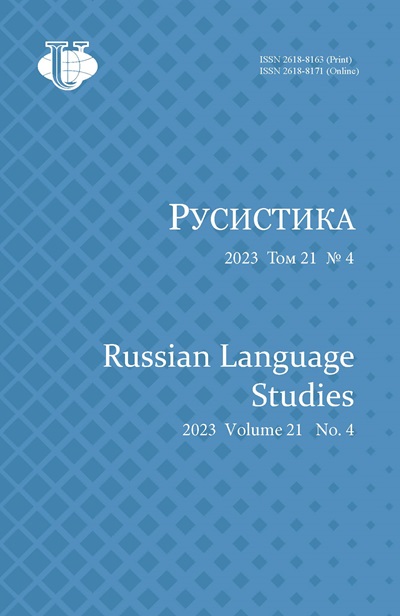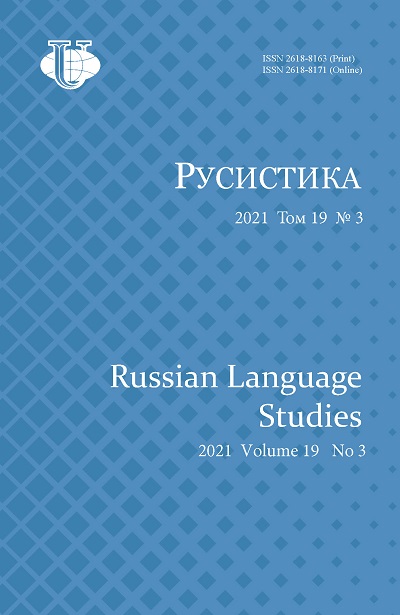Teaching Russian verbs of motion to Turkish students, considering national linguistic picture of the worlds
- Authors: Khavronina S.A.1, Emrak K.1
-
Affiliations:
- Peoples’ Friendship University of Russia (RUDN University)
- Issue: Vol 19, No 3 (2021)
- Pages: 313-330
- Section: Methods of teaching russian as a foreign language
- URL: https://journals.rudn.ru/russian-language-studies/article/view/27497
- DOI: https://doi.org/10.22363/2618-8163-2021-19-3-313-330
Cite item
Full Text
Abstract
The article deals with Russian prefixed verbs of motion in the reflection of the Turkish language. The topic is relevant due to the fact that in recent years the role of Russian language learning in Turkey is increasing because of the expansion of economic and cultural relations between the two countries. The aim of the study is to create a linguodidactic basis for developing methodological recommendations for teaching Russian prefixed verbs of motion to Turkish students. Different methods have been used to realize the goal. The article is based on the dissertations, textbooks and manuals on the Russian language for foreigners, scientific works comparing the Russian and Turkish languages. The study of verbs of motion in the practical course of the Russian language for Turkish students has a special place. Russian and Turkish language speakers perceive the world and their identity differently. The differences between the pictures of the world are reflected in culture and language, its vocabulary and grammatical categories. Thus, while there are universals in the verb systems of the Russian and Turkish languages, there are also significant differences in the idea of action, state, change, movement, denoted by verb units in the two languages. Russian prefixed verbs of motion do not have exact equivalents in Turkish and are translated by means of verbs with different root or translation transformations. The results of the comparative description of Russian prefixed verbs of motion and transferring their meanings in Turkish, and the identified differences served as the basis for developing methodological recommendations for teaching Russian prefixed verbs of motion to Turkish students, taking into account their native language. Basing on the research, a system of teaching prefixed verbs of motion to Turkish students, including methods of verb presentation and consolidation in oral and written speech, was developed. The prospects of this work are to create a nationally-oriented textbook on the topic “Russian prefix verbs of motion”.
Full Text
Table 1. Verbs with prefix при- (pri-)
PERFECTIVE ASPECT | IMPERFECTİVE ASPECT |
Where? To whom? From where? From whom? | |
The non-transitive verbs of motion with the prefix при- (pri-) correspond to the Turkish verb gelmek (прийти – to come), as well as the verbs varmak (добраться – to get to), uğramak (зайти – I came (приехал) to have some fun, but I am bored here, and I want to go home again (A. Chekhov, “Ivanov”). Sözüm ona eğlenmek için geldim buraya, işte burada da sikiliyorum, eve dönmek istiyorum. | |
Table 2. Prefixal verbs and their Turkish equivalents
Прийти | Приходить |
Мои новые друзья пришли ко мне в гости. Мои новые друзья придут ко мне в гости.)
| Юсуф после уроков приходил домой. Юсуф после уроков приходит домой. Юсуф после уроков будет приходить домой. |
Приехать | Приезжать |
Айше приехала в Стамбул в сентябре. Айше приедет в Стамбул в сентябре.
| Ахмет приезжал в Стамбул каждое лето. Ахмет приезжает в Стамбул каждое лето. Ахмет будет приезжать в Стамбул каждое лето. |
Figure 1. Verbs of motion with prefix при- (pri-)
Table 3. Verbs with prefix под- (pod-)
PERFECTİVE | IMPERFECTİVE |
To whom? To what? | |
Verbs with the prefix под- (pod-) are conveyed by the Turkish verb gelmek and the adverb yanına, if the movement is directed to an animate person (to approach someone); when the movement is directed to an object the verb yaklaşmak (to approach something) is used, and also the verb gelmek. Metin approached (подошел к) the teacher and asked a question. Metin öğretmenin yanına geldi ve bir soru sordu. Nur walked up to (подошла к) the university and decided to wait for her friend. | |
Table 4. Prefixal verbs and their Turkish equivalents
Подойти | Подходить |
Мои новые друзья подошли ко мне. Студенты подойдут к преподавателю.
| Юсуф подходил к учителю каждый раз после уроков. Юсуф после уроков подходит ко мне. Теперь Юсуф после уроков будет подходить к учителю за консультацией. |
Подъехать | Подъезжать |
Айше подъехала к Стамбулу на машине. Айше подъедет на работу к 7 утра.
| Когда Ахмет работал у нас, он подъезжал Ахмет медленно подъезжает к зданию общежития. Ахмет будет подъезжать к крыльцу. |
Figure 2. Verbs of motion with prefix под- (pod-)
About the authors
Serafima A. Khavronina
Peoples’ Friendship University of Russia (RUDN University)
Author for correspondence.
Email: khavronina@yandex.ru
PhD, Professor of the Department of the Russian Language and Its Teaching Methods
6 Miklukho-Maklaya St, Moscow, 117198, Russian FederationKasim Emrak
Peoples’ Friendship University of Russia (RUDN University)
Email: kasimemrak@gmail.com
PhD student of the Department of the Russian Language and Its Teaching Methods
6 Miklukho-Maklaya St, Moscow, 117198, Russian FederationReferences
- Amirdganyan, E.R. (2000). Verbs of movement with prefixes that convey temporal relations in the Russian language, and the possibilities of their transfer to the Armenian language. Russkii Yazyk v Armenii, (2), 60–70. (In Russ.)
- Azimov, E.G., & Shchukin, A.N. (2010). New dictionary of methodological terms and concepts: Theory and practice of language teaching. Moscow: ICARUS Publ. (In Russ.)
- Babakhanyan, M.G. (2015). Russian verbs of movement: An educational and methodological guide for teachers of the Russian language as a foreign language/non-native. Yerevan: YSU Publ. (In Russ.)
- Banguoğlu, T. (1976). Türkçenin Grameri. Ankara: Türk Dil Kurumu Yayınları Publ.
- Bitekhtina, G.A., & Yudina, L.P. (1985). System of work on the topic “Verbs of movement”. Moscow: Russkii Yazyk Publ. (In Russ.)
- Bondarko, A.V., & Bulanin, L.L. (1967). Russian verb: Manual for students and teachers. Leningrad: Prosveshchenie Publ. (In Russ.)
- Gadzhieva, N.Z., & Serebrennikov, B.A. (1979). Comparative-historical grammar of the Turkic languages: A textbook for universities. Baku: Maarif Publ. (In Russ.)
- Gadzhieva, N.Z., & Serebrennikov, B.A. (1986). Comparative-historical grammar of the Turkic languages: Syntax (E.R. Tenishev, Ed.). Moscow: Nauka Publ. (In Russ.)
- Isachenko, A.V. (2015). Verbs of movement in the Russian language. Russkiy Yazyk v Shkole, (4), 12–16. (In Russ.)
- Khavronina, S.A., & Balykhina, T.M. (2008). Innovative educational and methodological complex “Russian as a foreign language”: Textbook. Moscow: RUDN Publ. (In Russ.)
- Khavronina, S.A., & Dogan, M.G. (2019). On the question of studying Russian proper-reflexive verbs in the Turkish audience. Language and Culture, (46), 155–166. (In Russ.)
- Kononov, A.N. (1956). Grammar of the modern Turkish literary language. Moscow, Leningrad: USSR Academy of Sciences Publ. (In Russ.)
- Krasnokutskaya, N.V. (2020). Implementing the principle of considering native language in Russian language textbooks for foreigners. Russian Language Studies, 18(3), 342–358. https://doi.org/10.22363/2618-8163-2020-18-3-342-358
- Letuchyi, A.B. (2016). Transition. Materials to the Corpus Grammar of the Russian Language. Verb (pp. 213–267). Saint Petersburg: Nestor-Istoriya Publ. (In Russ.)
- Muraveva, L.S. (2000). Verbs of movement in the Russian language. Moscow: Higher School of Economics Publ. (In Russ.)
- Rozhkova, G.I. (1983). On the linguistic foundations of the methodology of teaching Russian to foreigners. Moscow. (In Russ.)
- Shapovalova, T.E. (2015). From the experience of teaching the topic “The category of voice of the Russian verb” at the Faculty of Philology. (In Russ.) Retrieved April 7, 2021, from https://nbisu.moy.su/_ld/11/1193_T.E.Shapovalova.pdf
- Shvedova, N.Yu. (1999). Theoretical results obtained in the work on the “Russian syntactic dictionary”. Voprosy Yazykoznaniya, (1), 3–16. (In Russ.)
- Shvedova, N.Yu. (Ed.). (1980). Russian grammar (vol. 1). Moscow. (In Russ.)
- Skvortsova, G.L. (2010). Verbs of movement – without mistakes: A manual for students studying Russian as a foreign language (6th edition, p. 136). Moscow: Russkii Yazyk. Kursy Publ. (In Russ.)
- Tenishev, E.R. (1988). Comparative-historical grammar of the Turkic languages. Morphology. Moscow: Nauka Publ. (In Russ.)
- Türkçe Öğretiminde Çatı Konusu ve Biçime Dayalı Yeni Bir Sınıflama. (2011). Retrieved May 4, 2021. From https://www.researchgate.net/publication/333357017_Turkce_Ogretiminde
- Yudina, L.P., & Bitekhtina, G.A. (1976). Oral speech training exercises on the topic “Verbs of movement”: Workbook for studying with foreign students. Moscow: Russkii Yazyk Publ. (In Russ.)















